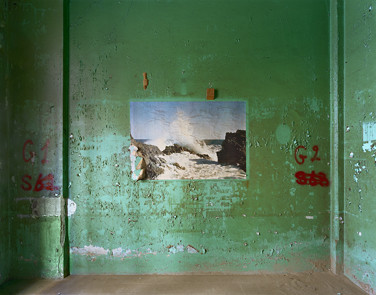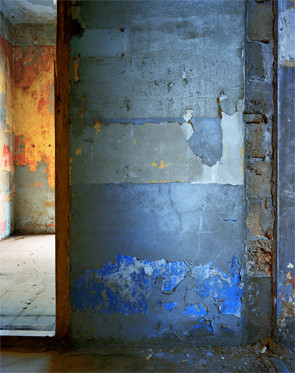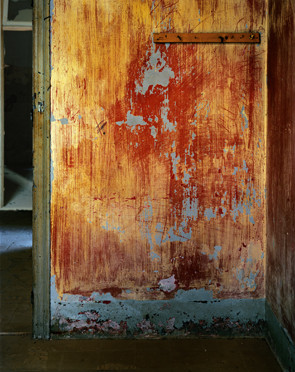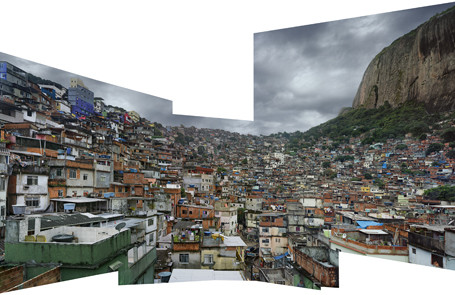Robert Polidori. Exteriors and Interiors
05 Sep 2014 - 17 Jan 2015

Robert Polidori
Hotel Petra #5, Beirut
2010
Aqueaous Inkjet on natural fiber paper mounted on Dibond
151,9 x 189,8 cm
Ed. 1/9 + 3 AP
Hotel Petra #5, Beirut
2010
Aqueaous Inkjet on natural fiber paper mounted on Dibond
151,9 x 189,8 cm
Ed. 1/9 + 3 AP

Robert Polidori
Hotel Petra #1, Beirut
2010
Aqueaous Inkjet on natural fiber paper mounted on Dibond
189,8 x 151,9 cm
Ed. 1/9 + 3 AP
Hotel Petra #1, Beirut
2010
Aqueaous Inkjet on natural fiber paper mounted on Dibond
189,8 x 151,9 cm
Ed. 1/9 + 3 AP

Robert Polidori
Hotel Petra #3, Beirut
2010
Aqueaous Inkjet on natural fiber paper mounted on Dibond
189,8 x 151,9 cm
Ed. 1/9 + 3 AP
Hotel Petra #3, Beirut
2010
Aqueaous Inkjet on natural fiber paper mounted on Dibond
189,8 x 151,9 cm
Ed. 1/9 + 3 AP

Robert Polidori
Favela Rocinha # 1, Rio de Janeiro
2009
UV-Cured ink on Aluminium
Ed. 1/2 + 2 AP
285,1 x 449,6 cm
RP/F 151
Favela Rocinha # 1, Rio de Janeiro
2009
UV-Cured ink on Aluminium
Ed. 1/2 + 2 AP
285,1 x 449,6 cm
RP/F 151
Galerie Karsten Greve is pleased to present a comprehensive solo exhibition of new photography by Robert Polidori, which places multiple groups of his works in dialogue with one another. In Exteriors and Interiors, images from his series Hotel Petra and Dendritic Cities will be shown for the first time, works that the photographer, b. 1951 in Montréal, Canada, produced between 2008 and 2011. Polidori’s views of exterior and interior spaces in their urban contexts are like portraits that make the passage of time visible in present-day images.
Hotel Petra is composed of interior views of a building that has been shaped by acts of violence and by natural processes of decay. While in Beirut, Polidori sought out the once-dignified Hotel Petra, which had remained sealed off for nearly 23 years following the destruction of the Lebanese civil war. Sheltered from all human intervention, the building succumbed to ‘natural’ forms of decay. The walls are covered with numerous coats of paint that, over time, have flaked away and faded to the point that the underlying colours reveal themselves in changing tones and intensities. These processes of deterioration caused by age produce a broad spectrum of nuances: “The blue, yellow and orange tones and the unbelievable range of colours fascinated me at once. The scene is a sort of study of the flaking and layering of colours.” (Polidori)
Yet Polidori emphasises not only the painterly quality of these walls, but also the historical aspect that inhabits this “natural painting”. He describes the abstract forms that arise due solely due to the passage of time as “the archaeology of painting”: “Walls are the support on which time becomes visible.” (Polidori)
With the snap of the camera shutter, time and its effects are encompassed: the state captured by Polidori becomes an historical manifestation. The chromatic gradations reveal – in a way similar to an elipses – the chronology of past events. The characteristic surface texture of the building, whose damaged beauty serves as an emblem to nearby residents of the painful experience of the war, can be conceived of not only as a portrait, but also a memorial: a symbol of the collective memory. Although he recognises the poetic quality of the worn-away, faded tones, Polidori is no proponent of the romanticisation and aestheticisation of ruins. Instead, he follows his need to capture and realistically document the “memory of the walls” with his camera, going beyond the awareness of the visible to steer our attention to the concealed background “to get a complete picture of what really happened.” (Polidori) Since surface details always constitute clues for Polidori – indicators of deeper structures – the situations he depicts are witnesses to decisive social, historical and political changes that have left their mark in a singular, concrete form. In the exhibition, the juxtaposition of this ‘natural’ painting with the photographs of historic paintings at the Chateau de Versailles (from his series “Parcours Muséologique Revisité”) emphasises the fact that Polidori, through his painstaking observation of the circumstances he stumbles across, highlights the tangible remains of the past.
“I‘m interested in the traces left by the passage of time in a room, a building or a city.“ (Polidori) The artist also pursues these traces in the panoramas of his series entitled “Dendritic Cities”. Here he confronts the phenomenon of the rampant growth of so-called cités sauvages, whose uncontrolled spread around the edges of major cities follows no principle of urban planning, but is rather a direct result of socioeconomic conditions. Whether it is a slum in India or a Favela in Brazil, Polidori is always fascinated by such cities, which “spring up suddenly and disappear again after 50 years. They are temporary structures that grow up out of necessity.”
One of these scenarios of change in which a temporal development makes itself noticeable is the Indian slum of Dharavi. Originally located on the outskirts of India’s megalopolis Mumbai, it quickly became engulfed so
that today – unusually for a slum – it lies right in the middle of the city. In order to cope with the acute lack of space, old structures are torn down and new, improvised living spaces are built for the constant influx of people. Similar to the layers of paint on the wand of the Hotel Petra, the shacks are piled one on top of the other, surrounded by a confusing mass of one- and two-storey buildings. The quickly changing appearance of the city is also portrayed in the views of Amman, Jordan. Nearly all of the buildings pictured were built after 1991 when, as a consequence of the conflict in Iraq and the expulsion of Palestinians from Kuwait, the city received a wave of refugees, making the construction of emergency housing a necessity.
In contrast to his interiors, which are shot with a long exposure, these images are composed of many individual short-exposure photographs of a preexistent situation, which he pieces together into a multilayer composition whose irregular contour can be viewed as a formal equivalent of the unregulated, unrestrained urban sprawl. The new compositions contains individual details that originate from multiple perspectives instead of just one. Polidori does not select just one decisive moment, but gives equal value to multiple “decisive moments” (Polidori), so that they coexist simultaneously within the picture. With this approach he comments at once on the recording of history, which is replaced or altered by processes of layering and suppression of certain perceptions of that which happened, the plurality overridden by one single perspective. When applied to personal experience, the act of remembering also transforms our experience by a permanent regrouping and reordering of memories.
Robert Polidori and moved to New York in the 1970s, where he initially worked for Jonas Mekas at the Anthology Film Archive. In 1980 he received his Master’s Degree from the State University of New York. He has twice been honoured with the Alfred Eisenstaedt Award for Magazine Photography (1999 and 2000). In 1998 he received the World Press Award for his documentation of the construction of the Getty Museum, and in 2007 and 2008 he received the Communication Arts Award. Polidori’s work is represented in prestigious public collections including the Metropolitan Museum of Art in New York, the Victoria and Albert Museum in London and the Bibliothèque Nationale in Paris. Robert Polidori lives and works in Los Angeles. He has received special recognition not only for his many years of work for The New Yorker, but also for extraordinary projects such as his long-term documentation of the renovation of the Château de Versailles, which he began in the mid-1980s and which has received numerous awards. Many art books of his work have been printed, most recently Eye and I, which contains impressive portraits.
Hotel Petra is composed of interior views of a building that has been shaped by acts of violence and by natural processes of decay. While in Beirut, Polidori sought out the once-dignified Hotel Petra, which had remained sealed off for nearly 23 years following the destruction of the Lebanese civil war. Sheltered from all human intervention, the building succumbed to ‘natural’ forms of decay. The walls are covered with numerous coats of paint that, over time, have flaked away and faded to the point that the underlying colours reveal themselves in changing tones and intensities. These processes of deterioration caused by age produce a broad spectrum of nuances: “The blue, yellow and orange tones and the unbelievable range of colours fascinated me at once. The scene is a sort of study of the flaking and layering of colours.” (Polidori)
Yet Polidori emphasises not only the painterly quality of these walls, but also the historical aspect that inhabits this “natural painting”. He describes the abstract forms that arise due solely due to the passage of time as “the archaeology of painting”: “Walls are the support on which time becomes visible.” (Polidori)
With the snap of the camera shutter, time and its effects are encompassed: the state captured by Polidori becomes an historical manifestation. The chromatic gradations reveal – in a way similar to an elipses – the chronology of past events. The characteristic surface texture of the building, whose damaged beauty serves as an emblem to nearby residents of the painful experience of the war, can be conceived of not only as a portrait, but also a memorial: a symbol of the collective memory. Although he recognises the poetic quality of the worn-away, faded tones, Polidori is no proponent of the romanticisation and aestheticisation of ruins. Instead, he follows his need to capture and realistically document the “memory of the walls” with his camera, going beyond the awareness of the visible to steer our attention to the concealed background “to get a complete picture of what really happened.” (Polidori) Since surface details always constitute clues for Polidori – indicators of deeper structures – the situations he depicts are witnesses to decisive social, historical and political changes that have left their mark in a singular, concrete form. In the exhibition, the juxtaposition of this ‘natural’ painting with the photographs of historic paintings at the Chateau de Versailles (from his series “Parcours Muséologique Revisité”) emphasises the fact that Polidori, through his painstaking observation of the circumstances he stumbles across, highlights the tangible remains of the past.
“I‘m interested in the traces left by the passage of time in a room, a building or a city.“ (Polidori) The artist also pursues these traces in the panoramas of his series entitled “Dendritic Cities”. Here he confronts the phenomenon of the rampant growth of so-called cités sauvages, whose uncontrolled spread around the edges of major cities follows no principle of urban planning, but is rather a direct result of socioeconomic conditions. Whether it is a slum in India or a Favela in Brazil, Polidori is always fascinated by such cities, which “spring up suddenly and disappear again after 50 years. They are temporary structures that grow up out of necessity.”
One of these scenarios of change in which a temporal development makes itself noticeable is the Indian slum of Dharavi. Originally located on the outskirts of India’s megalopolis Mumbai, it quickly became engulfed so
that today – unusually for a slum – it lies right in the middle of the city. In order to cope with the acute lack of space, old structures are torn down and new, improvised living spaces are built for the constant influx of people. Similar to the layers of paint on the wand of the Hotel Petra, the shacks are piled one on top of the other, surrounded by a confusing mass of one- and two-storey buildings. The quickly changing appearance of the city is also portrayed in the views of Amman, Jordan. Nearly all of the buildings pictured were built after 1991 when, as a consequence of the conflict in Iraq and the expulsion of Palestinians from Kuwait, the city received a wave of refugees, making the construction of emergency housing a necessity.
In contrast to his interiors, which are shot with a long exposure, these images are composed of many individual short-exposure photographs of a preexistent situation, which he pieces together into a multilayer composition whose irregular contour can be viewed as a formal equivalent of the unregulated, unrestrained urban sprawl. The new compositions contains individual details that originate from multiple perspectives instead of just one. Polidori does not select just one decisive moment, but gives equal value to multiple “decisive moments” (Polidori), so that they coexist simultaneously within the picture. With this approach he comments at once on the recording of history, which is replaced or altered by processes of layering and suppression of certain perceptions of that which happened, the plurality overridden by one single perspective. When applied to personal experience, the act of remembering also transforms our experience by a permanent regrouping and reordering of memories.
Robert Polidori and moved to New York in the 1970s, where he initially worked for Jonas Mekas at the Anthology Film Archive. In 1980 he received his Master’s Degree from the State University of New York. He has twice been honoured with the Alfred Eisenstaedt Award for Magazine Photography (1999 and 2000). In 1998 he received the World Press Award for his documentation of the construction of the Getty Museum, and in 2007 and 2008 he received the Communication Arts Award. Polidori’s work is represented in prestigious public collections including the Metropolitan Museum of Art in New York, the Victoria and Albert Museum in London and the Bibliothèque Nationale in Paris. Robert Polidori lives and works in Los Angeles. He has received special recognition not only for his many years of work for The New Yorker, but also for extraordinary projects such as his long-term documentation of the renovation of the Château de Versailles, which he began in the mid-1980s and which has received numerous awards. Many art books of his work have been printed, most recently Eye and I, which contains impressive portraits.
